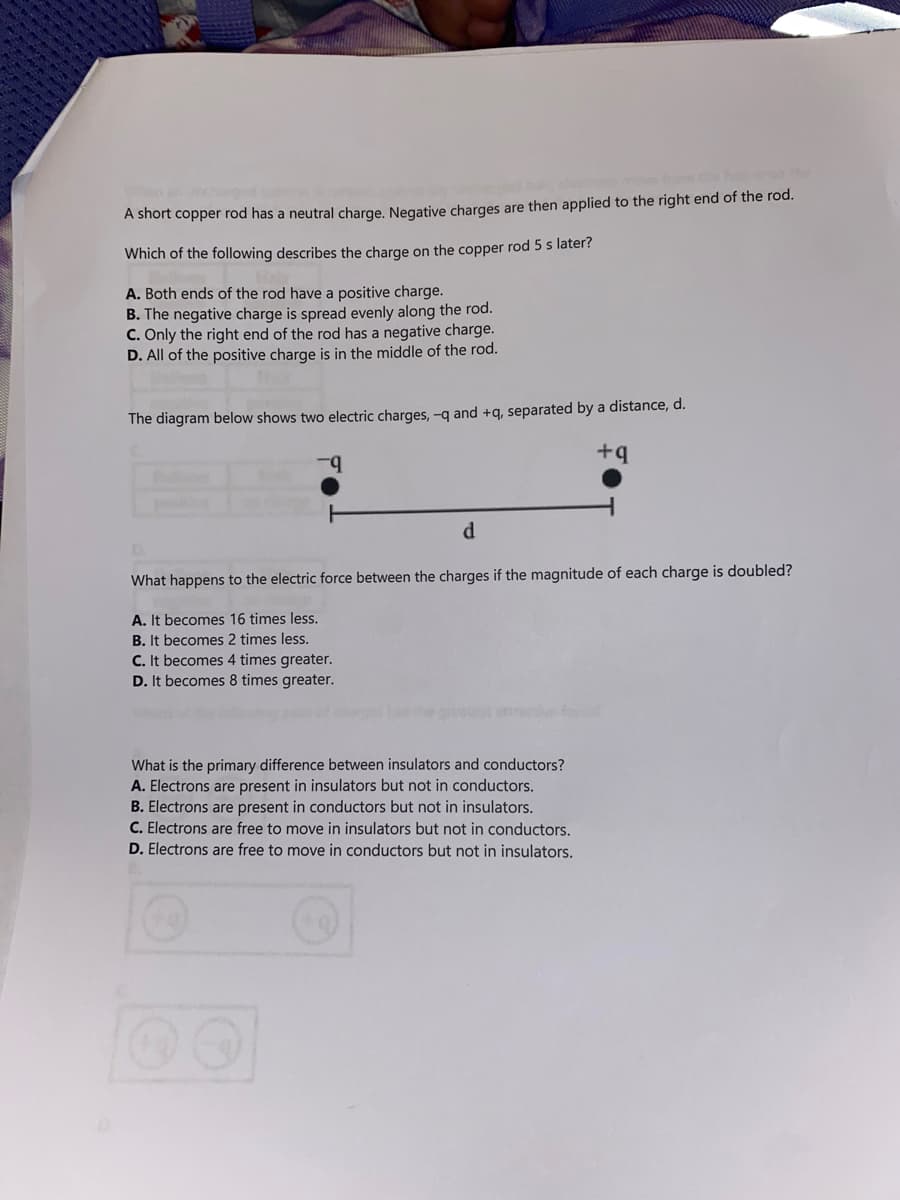A short copper rod has a neutral charge. Negative charges are then applied to the right end of the rod. Which of the following describes the charge on the copper rod 5 s later? A. Both ends of the rod have a positive charge. B. The negative charge is spread evenly along the rod. C. Only the right end of the rod has a negative charge. D. All of the positive charge is in the middle of the rod. The diagram below shows two electric charges, -q and +q, separated by a distance, d. +q -9 d What happens to the electric force between the charges if the magnitude of each charge is doubled? A. It becomes 16 times less. B. It becomes 2 times less. C. It becomes 4 times greater. D. It becomes 8 times greater. What is the primary difference between insulators and conductors? A. Electrons are present in insulators but not in conductors. B. Electrons are present in conductors but not in insulators. C. Electrons are free to move in insulators but not in conductors. D. Electrons are free to move in conductors but not in insulators.
A short copper rod has a neutral charge. Negative charges are then applied to the right end of the rod. Which of the following describes the charge on the copper rod 5 s later? A. Both ends of the rod have a positive charge. B. The negative charge is spread evenly along the rod. C. Only the right end of the rod has a negative charge. D. All of the positive charge is in the middle of the rod. The diagram below shows two electric charges, -q and +q, separated by a distance, d. +q -9 d What happens to the electric force between the charges if the magnitude of each charge is doubled? A. It becomes 16 times less. B. It becomes 2 times less. C. It becomes 4 times greater. D. It becomes 8 times greater. What is the primary difference between insulators and conductors? A. Electrons are present in insulators but not in conductors. B. Electrons are present in conductors but not in insulators. C. Electrons are free to move in insulators but not in conductors. D. Electrons are free to move in conductors but not in insulators.
Principles of Physics: A Calculus-Based Text
5th Edition
ISBN:9781133104261
Author:Raymond A. Serway, John W. Jewett
Publisher:Raymond A. Serway, John W. Jewett
Chapter19: Electric Forces And Electric Fields
Section: Chapter Questions
Problem 62P
Related questions
Question

Transcribed Image Text:A short copper rod has a neutral charge. Negative charges are then applied to the right end of the rod.
Which of the following describes the charge on the copper rod 5 s later?
A. Both ends of the rod have a positive charge.
B. The negative charge is spread evenly along the rod.
C. Only the right end of the rod has a negative charge.
D. All of the positive charge is in the middle of the rod.
The diagram below shows two electric charges, -q and +q, separated by a distance, d.
+q
-q
d
What happens to the electric force between the charges if the magnitude of each charge is doubled?
A. It becomes 16 times less.
B. It becomes 2 times less.
C. It becomes 4 times greater.
D. It becomes 8 times greater.
What is the primary difference between insulators and conductors?
A. Electrons are present in insulators but not in conductors.
B. Electrons are present in conductors but not in insulators.
C. Electrons are free to move in insulators but not in conductors.
D. Electrons are free to move in conductors but not in insulators.
Expert Solution
This question has been solved!
Explore an expertly crafted, step-by-step solution for a thorough understanding of key concepts.
This is a popular solution!
Trending now
This is a popular solution!
Step by step
Solved in 3 steps

Knowledge Booster
Learn more about
Need a deep-dive on the concept behind this application? Look no further. Learn more about this topic, physics and related others by exploring similar questions and additional content below.Recommended textbooks for you

Principles of Physics: A Calculus-Based Text
Physics
ISBN:
9781133104261
Author:
Raymond A. Serway, John W. Jewett
Publisher:
Cengage Learning

College Physics
Physics
ISBN:
9781285737027
Author:
Raymond A. Serway, Chris Vuille
Publisher:
Cengage Learning

College Physics
Physics
ISBN:
9781305952300
Author:
Raymond A. Serway, Chris Vuille
Publisher:
Cengage Learning

Principles of Physics: A Calculus-Based Text
Physics
ISBN:
9781133104261
Author:
Raymond A. Serway, John W. Jewett
Publisher:
Cengage Learning

College Physics
Physics
ISBN:
9781285737027
Author:
Raymond A. Serway, Chris Vuille
Publisher:
Cengage Learning

College Physics
Physics
ISBN:
9781305952300
Author:
Raymond A. Serway, Chris Vuille
Publisher:
Cengage Learning

Physics for Scientists and Engineers, Technology …
Physics
ISBN:
9781305116399
Author:
Raymond A. Serway, John W. Jewett
Publisher:
Cengage Learning

Physics for Scientists and Engineers
Physics
ISBN:
9781337553278
Author:
Raymond A. Serway, John W. Jewett
Publisher:
Cengage Learning

Physics for Scientists and Engineers with Modern …
Physics
ISBN:
9781337553292
Author:
Raymond A. Serway, John W. Jewett
Publisher:
Cengage Learning